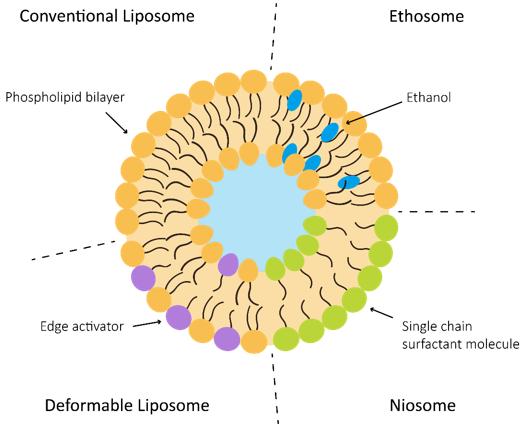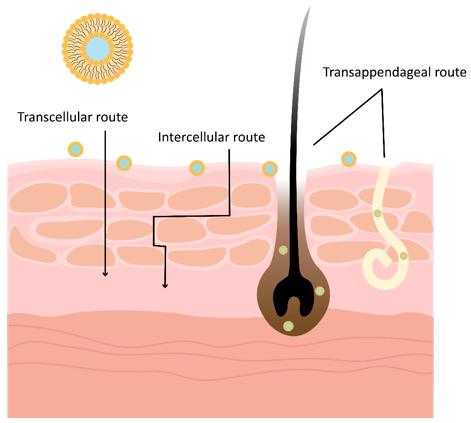As demand for precise skin therapies grows, liposomal delivery systems have become essential for overcoming skin barrier challenges and delivering active ingredients effectively. With a unique structure that stabilizes and targets both hydrophilic and lipophilic compounds, liposomes offer superior bioavailability and controlled release, ideal for modern dermatology. Creative Biolabs' Dermal Liposome Development Service delivers customized solutions, ensuring each formulation meets specific therapeutic needs, making it a leading choice in advanced skin-targeted treatments.
Creative Biolabs offers a wide range of advanced liposomal delivery systems tailored to meet the varied demands of dermal drug delivery. The service begins with detailed custom liposome formulation, tailoring key parameters like lipid composition, charge, and particle size for precise application. With a focus on encapsulating various active ingredients, we support clients in enhancing ingredient stability and bioactivity, particularly for sensitive compounds. Advanced liposome characterization and stability testing further ensure each formulation meets rigorous standards for quality and efficacy. This comprehensive service also includes liposome manufacturing expertise, allowing for a smooth transition from pilot formulations to commercial-scale production while maintaining regulatory compliance.
Alongside these core services, we provide specific liposome types, each offering unique advantages in dermal applications.
| Liposome Type | Composition | Structure | Properties | Mechanism of Action |
|---|---|---|---|---|
| Conventional Liposomes | Phosphatidylcholin Cholesterol | Spherical vesicles | Low skin permeability | Drug release to stratum corneum. |
| Transfersomes |
Phospholipids Edge activator Ethanol |
Flexible vesicles | Ultra-flexible, high deformability | Spontaneously penetrate skin by following water gradient. |
| Ethosomes |
Phospholipid High concentration of ethanol Water |
Soft, malleable vesicles | High elasticity, enhanced skin permeability. | Ethanol disrupts skin lipids, vesicles permeate skin. |
| Transethosomes |
Phospholipids Ethanol Edge activators |
Vesicles with high elasticity and ethanol | Combines properties of transfersomes and ethosomes. | Uses elasticity and ethanol to fluidize stratum corneum for deep penetration. |
| Niosomes |
Non-ionic surfactants Cholesterol |
Vesicles from non-ionic surfactants | Stable, low cost, good skin permeability. | Interacts with skin lipids to enhance drug penetration. |
| Invasomes |
Phospholipids Ethanol Terpenes |
Vesicles with permeation enhancers | Enhanced skin penetration, increased drug loading. | Terpenes disrupt stratum corneum lipids. |
| Menthosomes |
Phospholipids Cholesterol Menthol Ethanol |
Vesicles with menthol | High fluidity, elasticity. | Menthol disrupts stratum corneum for better vesicle movement. |
 Fig. 1 Different lipid carriers for dermal delivery.
Fig. 1 Different lipid carriers for dermal delivery.
Basics of Liposome Structure and Function
Liposomes are spherical vesicles composed of lipid bilayers, resembling cell membranes and making them highly compatible with biological systems. This makes them capable of containing hydrophilic and lipophilic medications, which means that liposomes can carry a wide variety of therapeutic agents. Their biocompatibility and their ability to preserve sensitive constituents from degrading enhance their drug delivery capabilities. In dermal formulations, liposomes anchor active compounds so that they can easily diffuse through the skin barrier and achieve the maximum therapeutic effects.
Mechanisms of Liposomal Penetration in Skin
The skin's outer layer, the stratum corneum, forms a strong, thick layer that resists drug absorption. By combining with skin lipids, adhesion to the surface, and endocytosis, liposomes are able to overcome this barrier. Additionally, manipulating liposome characteristics such as charge and particle size enhances retention and penetration. These modifications allow liposomes to carry therapeutic molecules deeper into the skin and deliver novel dermatological solutions.
 Fig.2 Different routes for dermal delivery.
Fig.2 Different routes for dermal delivery.
Dermal liposome delivery technologies have many benefits. These include greater stability, controlled release and improved bioavailability, all of which make liposomes highly suitable for dermatological purposes.
To support comprehensive dermal liposome development, a range of advanced platforms and technologies are utilized, ensuring precision, quality, and scalability across all service areas:
Liposomes are used in cosmetics to deliver active ingredients more effectively into the skin, enhancing their absorption and efficacy. They form a protective barrier, improving the stability and sustained release of compounds like vitamins, antioxidants, and moisturizers.
Liposomes provide effective transdermal delivery for systemic treatments, allowing drugs to bypass the digestive system and achieve targeted therapeutic effects. Additionally, localized delivery via liposomes minimizes systemic exposure, reducing potential side effects.
Liposomal systems are instrumental in R&D for studying skin permeation and drug efficacy, offering a controlled and flexible delivery model. Through custom dermal liposome development services, we support researchers in exploring innovative solutions for targeted skin delivery, enhancing experimental precision and outcomes.
Our dermal liposome development service offers distinct advantages that set us apart as a trusted partner for targeted skin delivery solutions. Key benefits include:
 For Research Use Only. Not For Clinical Use
For Research Use Only. Not For Clinical UseServices
Online Inquiry

